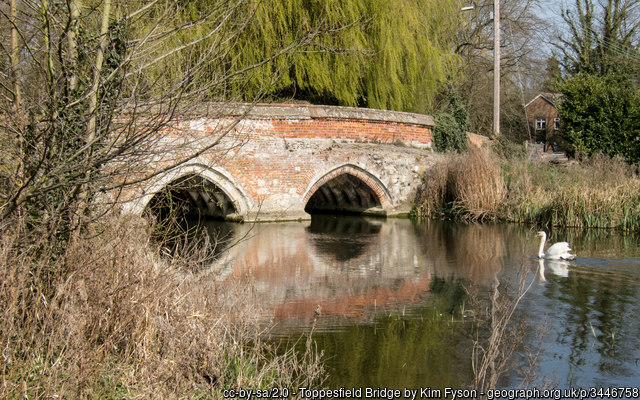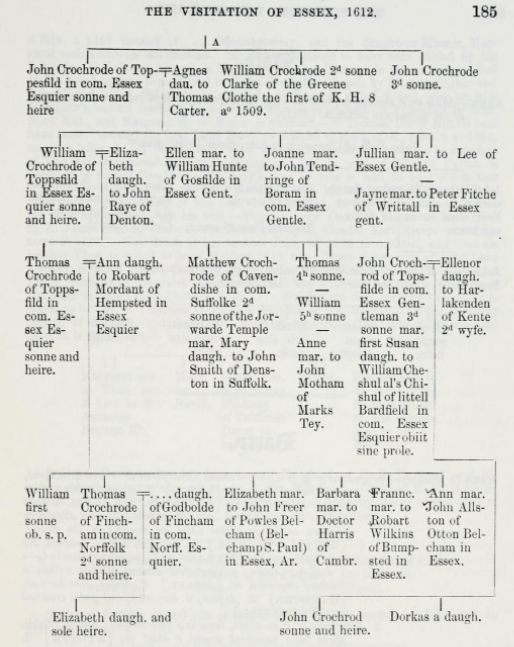
I find the Crachrodes rather fascinating – they have a very unusual name, and their family tree presents a puzzle. And as you may have noticed, I love a family history puzzle. I first met them when I encountered my ancestor Ralph Starling’s second wife, whose mother was born Joan Crachrode, and I’ve met them again through my research into the Mannocks.
First of all, the name can be spelled in all manner of ways. The 1612 Essex Visitation spells the name Crochrode, but it’s also spelled Crachrode, Cratchrode, Crachrood, etc etc etc. I’m sticking with Crachrode, but where a document spells it differently, I’ll make a note. Otherwise you may struggle to find it! My sources are the Heralds’ Visitations, Morant’s History of Essex (which itself draws on a variety of resources), parish registers, and wills.
- John Crachrode (d1534) and Agnes Carter
- William Crachrode and Elizabeth Ray (to follow)
- more to follow…
The tree in the Visitation goes from the times of Edward III up to 1612, starting with Robart Crachrode “who lived in the tyme of Kinge Edward 3d a. 15 of his Raynge 1341.”[1]I’m not sure if that a. 15 means that Robert was 15 years old in 1341. It might do. Then we meet his son and heir Thomas, who was a gentleman “whoe wente with the Erle of Oxford to Agencourte.” I wonder if there’s a generation missed between Robert and Thomas though as Agincourt took place in 1415. Thomas’ son John married Agnes, the daughter of John Gates. John Gates was the third son of Sir John Gates of Rivenhall, a knight. I assume that another descendant of Sir John’s (perhaps a grandson or great-grandson) was Sir John Gates (1504-1553), whose estates in Rivenhall and Shalford were confiscated after his execution at the Tower of London for his part in trying to keep Lady Jane Grey on the throne.
The Visitation then shows us three sons of John and Agnes: John, whose descendants I’ll be telling you about; William, their second son, “Clarke of the Greene Clothe”, which meant he worked in Henry VIII’s household, and a third son, also called John.
But Morant’s relating of the earlier history of the Crachrodes doesn’t quite align with the Visitation. Under the heading of “The maner of Cust Hall” in Toppesfield, Morant tells us that the manor was first owned by the Cust family, according to “ancient Deeds”, and that the first Crachrode to appear on the scene was John, “witness to a deed” in 1393. Morant says that John was the father of Robert, and that Robert was the father of John, who was at Agincourt (rather than Thomas). Which is all rather confusing and without looking at these ancient deeds myself (which may not be possible because while they existed in Morant’s time in the 1700s, three hundred years have gone by since and they might have all turned to dust), I’m not sure I’ll be any the wiser. He says that John and Agnes’ third son wasn’t another John, but a Thomas, who Morant says married Bridget de Vere, daughter of John, the 15th Earl of Oxford – but Morant has got a little muddled here as that marriage was a few generations on, as you will find out.
But Morant does agree that the eldest son of John Crachrode and Agnes Gates was also a John – and Morant tells us that in 1504, this eldest son “paid an ingress fine for Cust Hall in 1504.”
And it’s John we’re going to visit now, but just for reference, here’s his family, as told by the 1612 Visitation of Essex:
Footnotes
| ↑1 | I’m not sure if that a. 15 means that Robert was 15 years old in 1341. It might do. |
|---|

